
The International Union for Conservation of Nature (IUCN) Red List of Threatened Species, also known as the IUCN Red List or Red Data Book, founded in 1964, is an inventory of the global conservation status and extinction risk of biological species. A series of Regional Red Lists, which assess the risk of extinction to species within a political management unit, are also produced by countries and organizations.

The conservation status of a group of organisms indicates whether the group still exists and how likely the group is to become extinct in the near future. Many factors are taken into account when assessing conservation status: not simply the number of individuals remaining, but the overall increase or decrease in the population over time, breeding success rates, and known threats. Various systems of conservation status are in use at international, multi-country, national and local levels, as well as for consumer use such as sustainable seafood advisory lists and certification. The two international systems are by the International Union for Conservation of Nature (IUCN) and The Convention on International Trade in Endangered Species of Wild Fauna and Flora (CITES).

Syzygium cumini, commonly known as Malabar plum, Java plum, black plum, jamun, jaman, jambul, or jambolan, is an evergreen tropical tree in the flowering plant family Myrtaceae, and favored for its fruit, timber, and ornamental value. It is native to the Indian subcontinent and Southeast Asia, including Myanmar, Sri Lanka, Bangladesh and the Andaman Islands. It can reach heights of up to 30 metres (98 ft) and can live more than 100 years. A rapidly growing plant, it is considered an invasive species in many world regions.
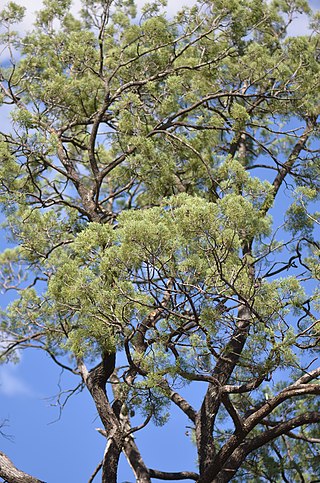
Callitris columellaris is a species of coniferous tree in the family Cupressaceae, native to most of Australia. Common names include white cypress, white cypress-pine, Murray River cypress-pine, Bribie Island pine and northern cypress-pine. Callitris columellaris has become naturalised in Hawaii and in southern Florida.

Phyla nodiflora, commonly known as the Turkey Tangle Frogfruit, is a species of flowering plant in the family Verbenaceae. It can be found in the Tropics around the globe. It is often grown as an ornamental plant for ground cover, and is often present in yards or disturbed areas.

Carpoxylon macrospermum is a species of palm tree endemic to Vanuatu, and the only species in the genus Carpoxylon.

The ashy minivet is a passerine bird of eastern Asia belonging to the minivet genus Pericrocotus in the cuckooshrike family Campephagidae. While most of the minivets have shades of yellow, orange and red in their plumage, this species has only greys, whites and blacks. The male is distinctive with a white face and black nape although females can be confused with the female of the brown-rumped minivet. They forage in the canopy, often along with other minivets and join mixed-species foraging flocks.
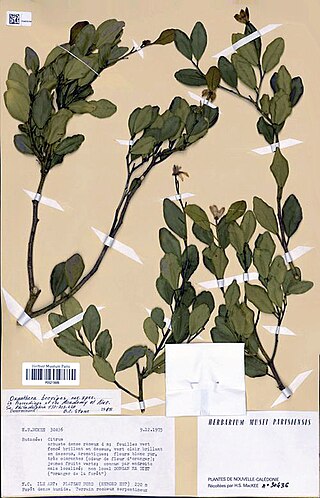
Oxanthera brevipes is a species of plant in the family Rutaceae. It is endemic to New Caledonia. It was proposed as a novel species by Benjamin C. Stone based on two specimens, distinguished from other false oranges by a non-articulated petiole. The genus Oxanthera has been synonymized with Citrus, but a name in Citrus does not appear to have been published, and Plants of the World Online regards "Oxanthera brevipes" as an unplaced name.
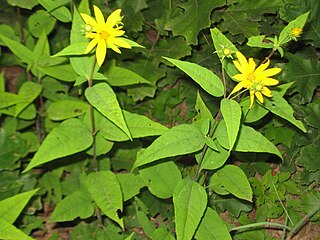
Helianthus divaricatus, commonly known as the rough sunflower, woodland sunflower, or rough woodland sunflower, is a North American species perennial herb in the family Asteraceae. It is native to central and eastern North America, from Ontario and Quebec in the north, south to Florida and Louisiana and west to Oklahoma and Iowa.
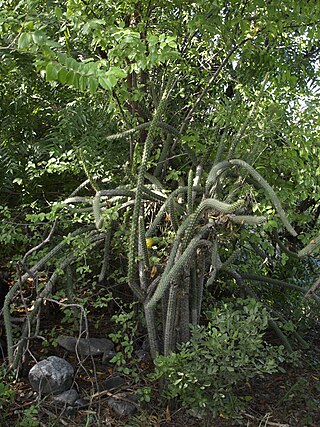
Harrisia divaricata is a species of cactus endemic to Hispaniola.

Adenocarpus is a genus of flowering plants in the family Fabaceae. It belongs to the subfamily Faboideae. The plants are broom-like shrubs with bright yellow flowers. The genus is native to the Mediterranean Basin and sub-Saharan Africa, but finds its highest diversity in Northwest Africa and the Iberian Peninsula.
Sphenopus, is a genus of Asian and Mediterranean plants in the grass family.

Strophanthus divaricatus is a liana or sarmentose shrub that can grow up to 4.5 metres (15 ft) tall, with a trunk diameter of up to 4 centimetres (1.6 in). Divaricatus is from the Latin meaning "spreading at a wide angle". The plant has been used medicinally: as a heart stimulant and in the treatment of snakebites. It is native to southern China and northern Vietnam.

Austrogomphus divaricatus, also known as Austrogomphus (Pleiogomphus) divaricatus, is a species of dragonfly of the family Gomphidae, commonly known as the fork hunter. It inhabits streams and rivers in northern Queensland, Australia.

Plagianthus is a genus of flowering plants confined to New Zealand and the Chatham Islands. The familial placement of the genus was controversial for many years, but modern genetic studies show it definitely belongs in the Malvaceae subfamily Malvoideae. The name means "slanted flowers".

Ptilotus divaricatus is a shrub in the Amaranthaceae family.
Melittacanthus divaricatus is a species of flowering plant belonging to the family Acanthaceae. It is a subshrub native to central and east-central Madagascar. It is the sole species in genus Melittacanthus.
Sphenopus divaricatus is a species of grass in the family Poaceae.
Eurolophosaurus divaricatus is a species of South American lava lizard in the family Tropiduridae. The species is endemic to Brazil.
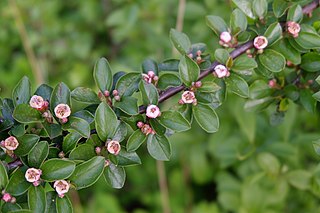
Cotoneaster divaricatus, the spreading cotoneaster, is a species of flowering plant in the family Rosaceae. It is native to China, and has been introduced to Ontario in Canada, the Midwest United States, northern and central Europe, Kenya, and the South Island of New Zealand. A shrub reaching 1.8 m (6 ft) tall but spreading to 2.4 m (8 ft), and hardy in USDA zones 4 through 7, it is considered a valuable landscaping plant by the Missouri Botanical Garden. The Centre for Agriculture and Bioscience International lists it in its Invasive Species Compendium.
















